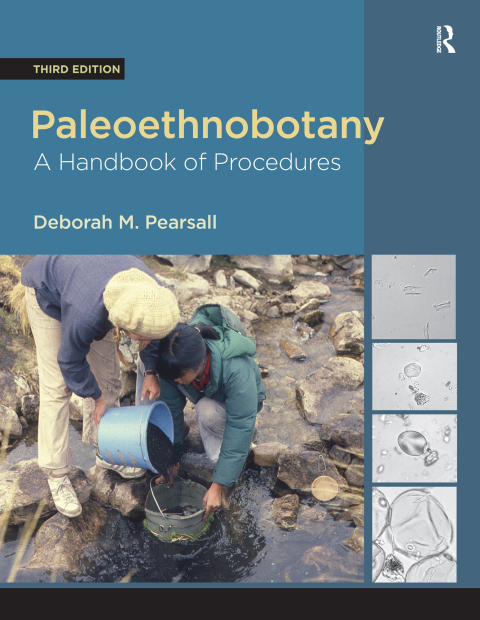Description
Efnisyfirlit
- Cover Page
- Half Title Page
- Title Page
- Copyright Page
- Contents
- Dedication
- List of illustrations
- Preface to the Third Edition
- Preface to the Second Edition
- Preface to the First Edition
- Chapter One The Paleoethnobotanical Approach
- Introduction
- Historical Overview
- Nature and Status of Ethnobotany
- Chapter Two Deposition, Preservation, and Recovery of Macroremains
- Introduction
- Deposition and Preservation of Macroremains
- Deposition of Macroremains
- Preservation of Macroremains
- In Situ Collection of Macroremains
- Screening Techniques
- Water Recovery: Flotation Techniques
- Terminology
- Development of Flotation in the New World
- Development of Flotation in the Old World
- Machine-Assisted Flotation in North America
- Building and Operating Flotation Systems: Sample Designs
- Manual Flotation
- Machine-Assisted Flotation: Water Separators and SMAP Machines
- Machine-Assisted Flotation: Froth Flotation
- Sampling for Macroremains
- Strategies for Sampling
- Sampling Techniques
- Hints for Good Sampling
- Issues and Directions in Recovery of Macroremains
- Choosing a Recovery System
- Problem Soils
- Chemical Flotation
- Testing Flotation Recovery Rates
- Saltwater Flotation
- Chapter Three Identification and Interpretation of Macroremains
- Introduction
- Initial Processing of Samples
- Basic Hand-Sorting Procedures
- Subsampling Large Flotation Samples
- Alternatives to Hand Sorting
- Sorting Desiccated and Waterlogged Samples
- Building a Comparative Collection
- Plant-Collecting Procedures
- Pressing and Drying Specimens
- Identification of Comparative Materials
- Preparing a Working Laboratory Collection
- Basic Identification Techniques
- Seeds
- Fruits and Nuts
- Wood
- Roots and Tubers
- Fibers, Leaves, and Nonwoody Stems
- Cultivated Plant Material
- Specialized Identification Techniques
- Embedding, Sectioning, and Grinding
- Electron Microscopy
- Morphometric Analysis
- Residue Analyses
- Presenting and Interpreting Results
- Approaches to Interpretation
- Qualitative Presentation
- Quantitative Analysis
- Reporting Results
- Case Study 1: Dung Fuel or the Broad-Spectrum Revolution: Interpreting Seed Data from Ali Kosh and Abu Hureyra
- 2014 Case Study 1 Update
- Case Study 2: There Is More to Food Than Diet: Foodways and Political and Social Change in the Americas
- Issues and Directions in Macroremain Analysis
- Interpretation and Macroremain Deposition and Preservation
- The Meaning of Abundance Measures
- Proof and Falsification
- The Roles of Macroremain Analysis in Paleoethnobotany
- Chapter 4 Pollen Analysis
- Introduction
- Nature and Production of Pollen
- Pollen Development
- Pollen Grain Structure
- Pollen Dispersal Mechanisms
- History of Pollen Analysis
- Pollen Deposition and Preservation
- Pollen Deposition
- Pollen Preservation
- Field Sampling
- Sampling Strategies
- Taking Soil and Sediment Samples
- Sampling Modern Vegetation
- Laboratory Analysis
- Sampling a Core
- Soil Extraction Techniques
- Processing Coprolites
- Processing Floral Specimens
- Mounting Slides
- Counting and Identifying Pollen
- Presenting and Interpreting Results
- Presenting Data
- Interpreting Sedimentary Data
- Interpreting Archaeological Pollen Data
- Issues and Directions in Archaeological Pollen Analysis
- Preservation
- Context and Sampling Issues
- Methodological Concerns
- The Roles of Pollen Analysis in Archaeology and Paleoethnobotany
- Chapter 5 Phytolith Analysis
- Introduction
- Nature and Occurrence of Phytoliths
- Phytolith Formation
- Occurrence and Characteristics of Phytoliths
- Phytoliths and Archaeology: A Brief History
- Phytolith Deposition and Preservation
- Phytolith Deposition
- Phytolith Preservation
- Field Sampling
- Sampling Soil and Sediments
- Sampling Vegetation
- Laboratory Analysis
- Phytolith Laboratory
- Processing Procedures for Soil and Sediment
- Processing Comparative Plant Material
- Scanning, Counting, and Identifying Phytoliths
- Presenting and Interpreting Results
- Presenting Results
- Interpreting Phytolith Data
- Issues and Directions in Phytolith Analysis
- Phytolith Production Patterns
- Development of Standard Practices
- Understanding Phytolith Deposition and Preservation
- The Roles of Phytolith Analysis in Archaeology and Paleoethnobotany
- Chapter 6 Starch Analysis
- Introduction
- Nature and Production of Starch
- History of Starch Analysis
- Starch Deposition and Preservation
- Deposition of Starch
- Preservation of Starch
- Field Sampling
- Sediment Sampling
- Collecting Artifacts for Starch Analysis
- Laboratory Analysis
- Sampling Artifacts for Starch
- Extracting Starch from Residues and Sediments
- Sampling Comparative Plant Material
- Mounting Slides
- Counting and Identifying Starch
- Presenting and Interpreting Results
- Presentation of Results
- Interpreting Starch Data
- Issues and Directions in Archaeological Starch Analysis
- Understanding Modes of Starch Preservation and Modification
- Recovering Starch from Sediments and Residues
- Quantification
- Comparative Studies
- The Roles of Starch Research in Archaeology and Paleoethnobotany
- Chapter 7 Integrating Biological Data
- Part I: Indicators of Diet and Health
- Introduction
- Indirect Dietary Indicators
- Direct Indicators
- Part II: The Interplay of Dietary Indicators
- Predictions from Dietary Indicators
- Combined Indicators for Eight Neotropical Diets
- From Model to Reality: Two Archaeological Case Studies
- Conclusions
- References
- Index
- List of Contributors






Reviews
There are no reviews yet.